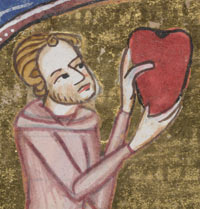 |
 |
 |
 |
 |
 |
 |
|
Byland Abbey: History
Byland Abbey: Buildings
|
Secret liaisons: from trial court to love-nest An interesting entry in the archiepiscopal records of William Greenfield (1306-1315) suggests that the abbot of Byland may have helped facilitate an illicit affair between Earl John of Warenne (1286-1347) and his mistress, ‘the fair and comely’ Maud Narford. Maud, it seems, was accommodated at the abbot’s house at Clifton, just outside York, when John was attending parliament at York. The archbishop of Canterbury had rejected John’s requests for a divorce from Edward I’s grand-daughter, Joan, and forbidden any illicit meetings with his mistress. John had thus turned to the archbishop of York, William Greenfield, to release him from his marriage. Greenfield responded by calling Maud to appear before him, and instructed the bishop of Durham to go to the abbot of Byland’s house at Clifton, where it was said that Maud was staying, and deliver a summons to this effect. The bishop was keen to point out that as Clifton lay outside his diocese this was not, strictly speaking, his duty, but went, nonetheless, to Clifton. Upon his arrival at the house, the bishop met several of the earl’s household attendants in the hall, but was not permitted to see Maud. After a lengthy wait he gave up and delivered his citation in the presence of public notaries.(3) Despite further attempts to terminate his marriage, John remained wedded to Joan until his death in 1347. Even so, he dabbled in a number of racy affairs; Maud, in fact, was simply one of several colourful dalliances which John embarked upon before and after his marriage to Joan. Some two years before his death in 1347, John confessed that prior to his marriage he had engaged in a relationship with her aunt, the Princess Mary, who was at that time a nun of Amesbury. Once married, John enjoyed a lengthy relationship with Maud, with whom he had two children; thereafter he was linked with the earl of Lancaster’s wife, whom he abducted, and Isabel of Holland, whom he referred to in his will as ‘ma compaigne.’(4) |
